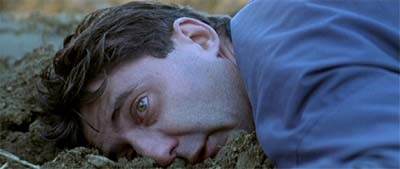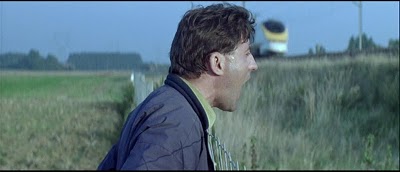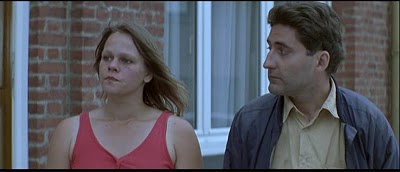From the Chicago Reader (June 23, 2000); also reprinted in my book Essential Cinema. — J.R.
L’humanité
Rating *** A must see
Directed and written by Bruno Dumont
With Emmanuel Schotté, Séverine Caneele, Philippe Tullier, Ghislain Ghesquière, and Ginette Allegre.
One of my favorite Italian novels, long out of print in English, is Carlo Emilio Gadda’s That Awful Mess on Via Merulana, a sort of Roman police procedural from 1946 in which the central crime never gets solved. The book is so beloved in Italy that it’s known simply as Il pasticciaccio (“the awful mess”), and when Gadda died in 1973 at the age of 79, it had gone through several editions.
William Weaver, who did the 1965 English translation, wrote in the preface that “Il pasticciaccio occupies in contemporary Italian literature the position that Ulysses, Remembrance of Things Past, and The Man Without Qualities occupy in the literature of their respective countries.” He also noted that many of Gadda’s other fictional works are “unfinished, but not incomplete. Even the briefest of Gadda’s fragments has its own curious wholeness; and if the ‘murder story’ aspect of Il pasticciaccio remains unresolved, one feels — at the end of this long, apparently ambling work — that it is better not to know who is responsible for the death of Signora Liliana. The reader feels that he has probed deeply enough already into the evil and horror of the world and that yet another, worse revelation of it would be more than the reader, the author, and the protagonist [Detective] Ingravallo could bear. Though students of Gadda’s work might not agree, one also suspects that his novels were born to be fragments, like certain imaginary ruins in Venetian painting, perfect parts of impossible wholes.”
On a busman’s holiday last month, I saw Pietro Germi’s 1959 adaptation of Il pasticciaccio, The Facts of Murder, at the Film Center and was disappointed but not surprised to find the plot “resolved,” the murderer uncovered. The feeling of infinitely expanding material in the novel had become not only finite in the film, but ultimately forgettable. On its own terms, the movie had many virtues, but it and the novel offer profoundly dissimilar experiences.
That led me to reflect on a few of the fundamental differences in how novels and movies are perceived. Kafka is allowed to leave all his novels unfinished — and, indeed, might not even be valued as much today if he’d forced conclusions on Amerika, The Trial, or The Castle. But Welles is castigated by most of his biographers for leaving a few of his films unfinished, and Eyes Wide Shut is automatically diminished in some people’s eyes for not having been fully mixed by Kubrick before he died. Similarly, we tolerate some paintings and symphonies having been left unfinished but not movies, the assumption being that their “formal” demands require some closure.
It’s an artistic double standard, and I believe certain films would be more honest and artistically and philosophically better if they’d been left unfinished. Unfortunately, the business of film distribution dictates that we generally don’t get to see unfinished films (Welles’s works are a prime example), and seeing only finished ones affects our expectations. It’s probably also true that some films only pretend to be finished, and that their real virtues are inextricably bound up with their unfinished qualities.
Foremost among the latter is Bruno Dumont’s powerful second feature, L’humanité, another police procedural, playing this week at Facets Multimedia. I hasten to add that the mystery in this case is solved at the end, and maybe it shouldn’t have been. Dumont himself seems open to this possibility when he writes in notes about the film distributed to the press:
“[Jean-Pierre] Melville used to say that the cop genre was a good vehicle.
“A police investigation is a sound movement…a dialectic: the quest for truth in a concrete and common expression, where it is innocently at work.
“The discovery doesn’t really matter. What counts is the movement: looking.”
I think Dumont’s film is unfinished in the sense that some paintings are; that is, some parts of the “canvas” are only sketched in while other parts are fully realized. As a mannerist portrait of a few individuals, it’s often amazing; as a spiritual statement about suffering in the contemporary world, it almost lives up to its title; for its blunt depictions of sex, it’s about as carnal in an unvarnished way as filmmaking can get; and as a visual rendering of an area of northern France (Dumont’s hometown, also the setting of his first feature, The Life of Jesus), it’s pretty impressive. But as a police procedural, it’s unsatisfying, far from being worked out in all its details.
Some of the details are even in direct conflict with some of the virtues I listed. For one thing, as Dumont pointed out in an interview with Toronto critic Mark Peranson, the film doesn’t qualify in any way as “realist,” though the nonprofessional actors and the locations may occasionally foster that impression — and lead one to expect a verisimilitude in the plot and the psychology of the characters that the film doesn’t furnish.
There’s nothing wrong about any of this. Given Dumont’s Dostoyevsky-like ambitions, it’s the most honorable sort of failing imaginable. Yet because it’s a movie and not a painting or a symphony, this failing has made some people angry. Last year a Cannes jury headed by David Cronenberg awarded L’humanité the grand jury prize and awards for best actor (Emmanuel Schotté) and actress (Séverine Caneele, in a tie with Rosetta‘s Emilie Duquenne), and the international press was scandalized. That both Schotté and Caneele were nonprofessionals contributed to the outrage, but other issues relating to “professionalism” were also at play — above all, conformity to genre expectations. The dramatic payoff in Dostoyevsky is hardly the same thing as the dramatic payoff in a serial-killer mystery, and anyone looking for the latter clearly felt cheated.
The crime in L’humanité is the rape and murder of an 11-year-old girl on her way home from school, and practically the first thing we see in the film is the anguished response of the hero, detective’s assistant Pharaon De Winter (Schotté), to seeing her naked body in a field. Not long afterward, Dumont tries to get us to share Pharaon’s trauma by focusing in close-up on her bloody crotch. Some of the remainder of this 148-minute film dutifully follows the investigation of the crime until an arrest is made, but the details of what happened and why never become a central concern.
The major focus is Pharaon, who lives with his mother and is silently though transparently smitten with his neighbor Domino (Caneele) — a factory worker who’s sexually involved with a loutish bus driver named Joseph (Philippe Tullier) and who frequently invites Pharaon along on excursions with her boyfriend. (She and Joseph are shown having sex three times in the film, something Pharaon accidentally witnesses once; but when she crudely offers to have sex with him he refuses.) We learn in passing that Pharaon had a girlfriend and a baby and “lost” both two years earlier, but no further details about them or what happened are forthcoming. This is perhaps the sketchiest detail of the film, and we may not even be able to accept it.
Some commentators maintain that Pharaon is unbelievable as a cop. My own small-town experience suggests that all kinds of people wind up in all kinds of jobs, but I’ll concede that he’s not entirely believable in some ways. I can at least buy that he’s sensitive, wide-eyed, and fairly ineffectual in most social situations. (An ironic and telling exception is when he breaks up a group of striking factory workers, Domino among them, who are trying to speak to the mayor.) Iconographically and poetically, he’s one of those tenderhearted “simple souls” we associate with D.W. Griffith — Richard Barthelmess’s nameless Chinese figure in Broken Blossoms (1919) is a key example — who are destined to be brutalized by the world at large, though Dumont doesn’t always idealize him. He’s a veritable stand-in for suffering humanity itself — critic Robin Wood maintains, with some justice, that this is a film “about Somalia, Kosovo, East Timor” and “school massacres,” among other things — and his practice of offering hugs to arrested criminals and to a doctor at a mental hospital is a good example of this movie’s periodic departures from realism. A more obvious example would be a brief shot that shows Pharaon levitating in his garden — a moment that places Dumont in the territory of Pier Paolo Pasolini (who created a comparable moment with Laura Betti in his Teorema) more than that of Robert Bresson.
Like Pasolini, Dumont seems to regard Christianity as a kind of continuing scandal. This implicit notion was also apparent in The Life of Jesus, which depicted a similar milieu of louts and sensitive souls in the same town in northern France, showed nudity and sex with the same carnal bluntness, and was similarly both broad and austere in its uses of sound (sparse and selective country noises) and image (‘Scope framing with lots of empty spaces).
A fearless filmmaker, Dumont seems willing to risk using characters as metaphors for metaphysical states of being even when this plays havoc with the usual expectations of storytelling. As a stylist, he likes to linger over his characters and landscapes with the firm patience of a portrait artist, and to allow a kind of calm wisdom to emerge from his contemplative moments. (This film is hysterical only in its subject matter.)
L’humanité is above all a film of physiognomies: the hero’s ruddy-cheeked, overweight boss is a kind of earthy physical type we’ve hardly ever seen before in movies — at least not since the 30s, when, as Manny Farber once pointed out, people hadn’t yet got into the habit of jogging and “every shape was legitimate.” Big-boned, desultory Domino, hanging out in front of her house like a refugee from Fassbinder’s Katzelmacher, is an even more painterly subject who seems to luxuriate in her own Amazonian diffidence. Like Pharaon, both of these characters seem to suggest that if you ponder some parts of the world long enough and hard enough, solving a mystery becomes a pretty trivial business, because it doesn’t prove a thing.





